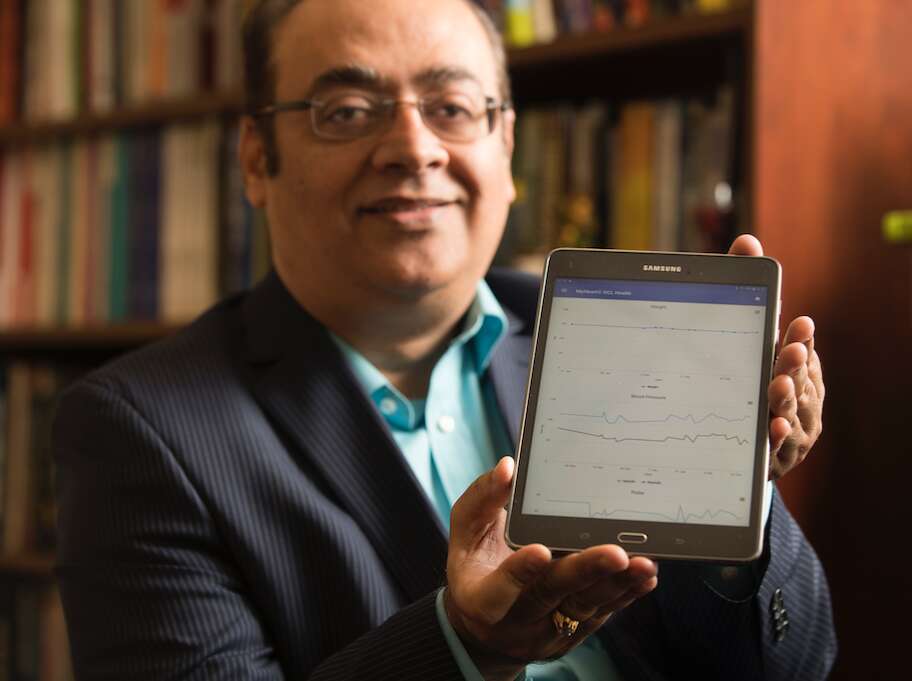‘You Don’t Need to be a Physician’: How Health Research is Changing

Something was wrong. Samir Chatterjee hadn’t heard from a close friend at another institution in nearly a month.
That may not seem like a very long time, but the pair talked constantly about working on projects together. His friend’s sudden silence worried him.
“He wasn’t answering any of my texts or voicemails, and it was really troubling,” recalled Chatterjee, who is the university’s Fletcher Jones Chair of Technology Design & Management in the Center for Information Systems & Technology (CISAT). “It wasn’t like him at all.”
The uneasy silence was broken—finally—when his friend’s wife called with sobering news: Her husband’s congestive heart failure had taken a sudden turn for the worse and he had been rushed to the hospital. Chatterjee was stunned. He had no idea his friend had been struggling.
“Here was a guy full of energy, full of plans,” he said. “How did it change so fast? Why didn’t he see it coming?”
A major change is taking place across the health and wellness landscape–and CGU is ready for it.
Chatterjee’s friend survived, but the experience—and these questions—soon inspired him to design the MyHeart system, which includes an app and remote monitoring technology.
The MyHeart app helps patients by collecting diagnostic data and other feedback on a daily basis. That information goes to a dashboard monitored by hospital caregivers. At the first sign of trouble, they can check in with the patient and decide if something simple will work—adjusting a medication, for example—or a more drastic intervention is needed.
“So much about healthcare today is really about helping people manage their behavior and their conditions,” said Chatterjee, “and technology can do that.”
Chatterjee’s insight reflects a much larger change taking place across the health and wellness landscape.
Health and wellness have long been dominated by the physician, surgeon, and the pharmaceutical industry. Not anymore.
Today, as more organizations recognize the impact of the behavioral side of disease—the psychological wiring, habits, and lifestyle choices that influence disease management and one’s quality of life—the old physician-centric model is being forced to make room for experts outside of the medical field (like Chatterjee) with innovative solutions.
In a 2018 World Health Organization (WHO) report on the dramatic rise of cancer, diabetes, heart disease, and other chronic non-communicable diseases (NCDs), the organization called for a shift from only symptom management and treatment to the inclusion of more prevention strategies. What is needed, the report says, are more cross-cutting collaborations and “multi-sectoral synergies” to “beat NCDs and promote mental health and well-being.”
At Claremont Graduate University, the WHO’s “multi-sectoral synergies” go by another name: transdisciplinarity—an approach to learning that recognizes that a single discipline or profession alone cannot solve the world’s complex challenges.
CGU’s health initiative is “an opportunity to produce real, lasting impact on people’s lives,” says President Len Jessup
For CGU President Len Jessup, such calls for collaboration to fight illness and promote wellbeing signal an important opportunity for the university. He and Patricia Easton, the university’s executive vice president and provost, are now exploring ways to leverage the university’s foundational transdisciplinary approach to position CGU at the forefront of a whole new paradigm of health and wellness research.

That exploration includes a new initiative that could bring together many of the university’s researchers and health organization partners studying illness and chronic disease to create a revolutionary new center devoted to health and wellness innovation and scalable solutions. The initiative is profiled in this summer’s issue of The Flame, the university magazine.
“This is an opportunity to produce a real, lasting impact on people’s lives,” Jessup said. “Today’s health challenges require the kind of thinking that breaks down traditional silos and departments, which is hard for larger, slower-moving institutions to do. But CGU is small and nimble. Our philosophy of research and training was made to handle these kinds of challenges.”
Chatterjee puts it another way.
“You don’t need to be a physician or a surgeon to work on health problems now,” said Chatterjee, who has gone on to design apps targeting other chronic conditions such as diabetes and COPD. “If you are a technologist or have innovative ideas and can partner with someone from another discipline, there is a lot that you can do.”
***
Interested in CGU’s efforts to address the world’s health challenges? Learn more by reading the summer issue of the Flame magazine online.